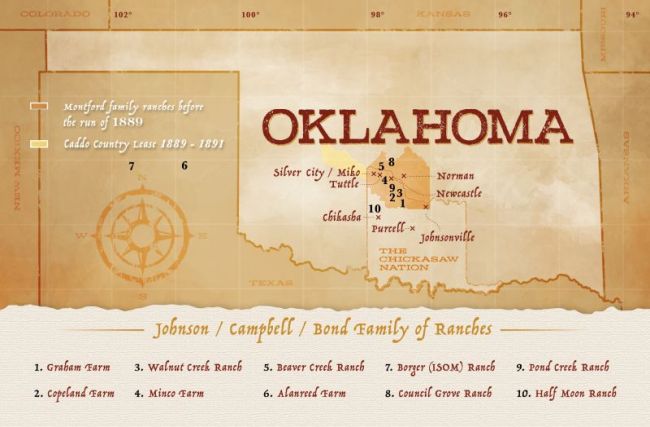In 1825, the Osage ceded the area north of the Canadian River to the United States. Part of this area was selected for the Creek and Seminole, who were removed from southeastern United States in the 1820s and 1830s. Following the Civil War (1861-65), the Creek and Seminole ceded their land as enforced by the Reconstruction Treaties of 1866. Vacated tribal lands became known as the Unassigned Lands, which were opened to non-First American settlers in the Land Run of 1889.
Uncertainty as Civil War Ends
Around 1858, Jesse Chisholm was operating a trading post at Council Grove, which was located west of present Oklahoma City. Seven years later, Confederate First American agent for the Creeks Israel G. Vore invited First Americans to meet at Council Grove and surrender as the Civil War ended. Threats from Union forces to disperse the meeting caused delegates to meet at Camp Napoleon May 24, 1865, to adopt a peace compact. Following the war, William McClure established the 7C Ranch near present Choctaw. Montford T. Johnson operated a ranch at Council Grove in the 1870s and 1880s. In 1879, Oklahoma boomer David L. Payne learned about the Unassigned Lands and led a group of settlers from Wichita, Kansas, to the south bank of the North Canadian River in spring 1880. Near present Oklahoma City, David Payne and his followers laid out a town called Ewing, named in honor of Union Gen. Thomas Ewing. The settlement was short-lived. Payne and his party were arrested and eventually escorted back to Kansas, [1] for violating the Indian Intercourse Act [2].
Johnson's Partnerships
Vicey “Granny” Harmon was a Chickasaw who became an important ranching partner for Johnson. She ran Council Grove Ranch, the most northern of the Johnson ranches [3, p. 83].
In 1870, Johnson declined to partner with Harmon on a store so instead she entered into a ranching partnership with him, the Council Grove Ranch. In 1879, the incursion of white settlers made maintaining the Council Grove Ranch too difficult mostly due to the fact that it was outside the boundaries of the Chickasaw Nation. Harmon moved her interests, as Johnson also did, to Silver City.
In 1881, Johnson, Charles Bryant Campbell's uncle, gave Charles and his sister Ella Campbell each 100 head of cattle and a ranch at Council Grove, within the present Oklahoma City metropolitan area. After several incidents with Boomers, who clamored for the Unassigned Lands, Johnson moved Charles Campbell to a ranch near present Purcell, offering him 20 horses and a partnership in another cattle herd. In 1884, Charles Campbell married Margaret Jane Williams, the daughter of "Caddo" Bill Williams, owner of the Half Moon Ranch, which specialized in breeding horses. By 1885, Charles Campbell had established his own ranch west of Silver City, a town on the Chisholm Trail, where his mother and relatives resided [4].

Map courtesy of the Chickasaw Nation
[1] L. Wilson, "Oklahoma County," Oklahoma Historical Society, [Online]. Available: https://www.okhistory.org/publications/enc/entry.php?entry=OK039 . [Accessed 25 8 2021].
[2] "Indian Intercourse Acts and the Treaty of New York," Collections and Reflections on American Legal History, [Online]. Available: https://www.statutesandstories.com/blog_html/indian-non-intercourse-acts-and-the-treaty-of-new-york/. [Accessed 25 8 2021].
[3] N. R. Johnson, The Chickasaw Rancher, Boulder: University Press of Colorado, 2001.
[4] L. O'DELL, "Seven BC Ranch," Oklahoma Historical Society, [Online]. Available: https://www.okhistory.org/publications/enc/entry.php?entry=SE025. [Accessed 25 8 2021].